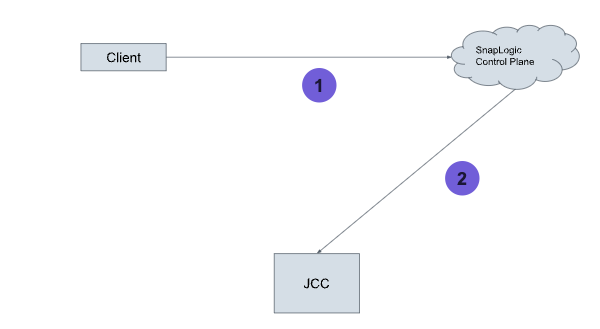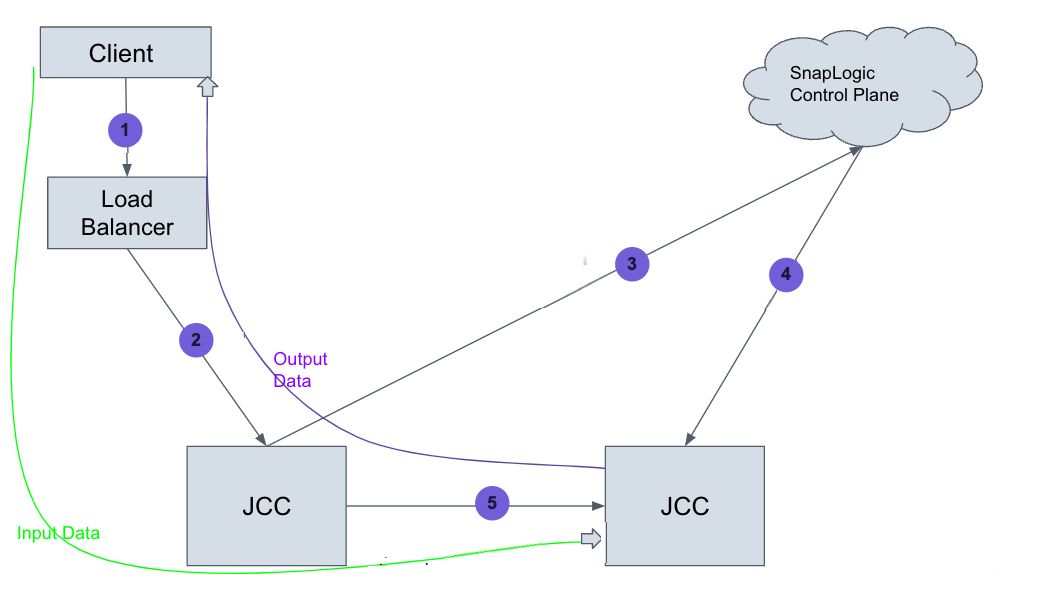Triggered Tasks
Triggered Tasks offer the method of invoking your pipelines with an HTTP endpoint. Your pipeline can now be treated as a service, to and from which clients can invoke to send or get data. You can invoke the pipeline underlying a Triggered Task from an on-premise system or from the cloud via the control plane.
Key features
- Create URL from a pipeline. You can create the URL through the task creation workflow in Designer or select a Target pipeline in Classic Manager
- Run as APIs. Once you have the task URL, you can pass data into pipelines or invoke the pipeline with predefined parameters.
- Access Control. You can set up an IP Allowlist and a CORS list at the Project level to enforce access control of Triggered Tasks.
- Network Configuration Options. You can configure your Snaplex instances and the Triggered Tasks that run on them for high availability and Disaster Recovery scenarios.
Triggered Task architecture
The following diagram shows the basic architecture for a Triggered Task being run via the control plane:

- Client uses cloud URL to trigger the API call against the control plane over an HTTPS connection.
- The pipeline is prepared and starts running on the Snaplex JCC node over the WebSocket for the input data and output stream.
Ground Triggered Task
The following diagram shows a Triggered Task being called via a load balancer to run on a Groundplex:

- The client triggers the task via the on-premises load balancer URL.
- The load balancer forwards the request to an active Groundplex node/Snaplex JCC
node.
- The Groundplex node that receives the Triggered Task request contacts
the control plane to get the needed assets/nodes to execute the
task.Note: These assets, once cached, can be used without communicating to the control plane.
- The control plane forwards the request to another active Groundplex node/Snaplex JCC node based on the pipeline load, and then sends the request over Websocket.
- The Groundplex node that receives the Triggered Task request contacts
the control plane to get the needed assets/nodes to execute the
task.
- The Triggered Task now prepares to be executed on the same Groundplex selected by the control plane. The streaming data is sent over an HTTPS connection.
You need to use a load balancer when using the Snaplex URLs to trigger a task. While load balancing happens between the Groundplex nodes, the node that receives the request executes the pipeline. If the Groundplex has only one node, then the Snaplex goes through downtime during a version upgrade.
Comparison of Triggered Task URLs
| Cloud URL |
|
|
| Snaplex/Alternate URLs |
|
|
Triggered Task workflow
This workflow represents actions taken by both SnapLogic Org admins and users.
-
You must have permissions to Project Space and Project to create and update Triggered Tasks.
-
You must have a Cloudplex or Groundplex set up to run Triggered Tasks successfully.
Triggered Tasks support the following HTTP methods:
- GET
- POST
- DELETE
- PUT
- PATCH
- HEAD
- The Open API specification (also known as Swagger) is supported. You can download your Triggered Tasks in API form in .
- The Cloud URL has a 15-minute connection limit, whether the connection is active or idle. Therefore, do no not use it for tasks that require streaming data in or out for longer than 15 minutes.
- A Snaplex comprises multiple nodes. If the Triggered Task is set to run on a Groundplex (also known as an on-premises Snaplex), there are multiple options for task URLs. These include a Cloud URL, which is reachable from the Cloud, and an on-premises URL and Override URL, both of which are limited to the on-premise network.
- A cloud URL Triggered Task fails when the task owner's password is expired. The task execution requires that the task owner’s password be reset. When using an on-premise URL, you can still trigger the task with the bearer token (refer to Task Details), even if the task owner’s password is expired. However, the task execution fails when using an expired password as authentication until the task owner's password is reset.
- When you access the URL for a Triggered or Ultra Task in a different Org from the one you last selected, SnapLogic Manager displays the task details. But, it does not automatically switch to the owning Org. To change Orgs, use the selector at the top right in Classic Manager.
- Because the connection to the client has a 15-minute timeout, long running pipelines invoked as Triggered or Ultra Tasks through a Cloudplex URL might not complete before the timeout occurs. For Groundplex users, this timeout does not apply to the on-premise URL.
When you create a Triggered Task and change the Run Policy to Scheduled, the Triggered Task URLs are not disabled. Therefore, the underlying pipeline is still executable through the Triggered Task URLs, even though the Task is now a Scheduled Task.
Workaround: Create a new Scheduled Task asset referencing the target pipeline and disable or delete the Triggered Task.


